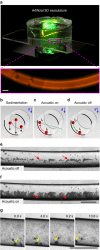Neutrophil-inspired propulsion in a combined acoustic and magnetic field
- PMID: 28974671
- PMCID: PMC5626690
- DOI: 10.1038/s41467-017-00845-5
Neutrophil-inspired propulsion in a combined acoustic and magnetic field
Abstract
Systems capable of precise motion in the vasculature can offer exciting possibilities for applications in targeted therapeutics and non-invasive surgery. So far, the majority of the work analysed propulsion in a two-dimensional setting with limited controllability near boundaries. Here we show bio-inspired rolling motion by introducing superparamagnetic particles in magnetic and acoustic fields, inspired by a neutrophil rolling on a wall. The particles self-assemble due to dipole-dipole interaction in the presence of a rotating magnetic field. The aggregate migrates towards the wall of the channel due to the radiation force of an acoustic field. By combining both fields, we achieved a rolling-type motion along the boundaries. The use of both acoustic and magnetic fields has matured in clinical settings. The combination of both fields is capable of overcoming the limitations encountered by single actuation techniques. We believe our method will have far-reaching implications in targeted therapeutics.Devising effective swimming and propulsion strategies in microenvironments is attractive for drug delivery applications. Here Ahmed et al. demonstrate a micropropulsion strategy in which a combination of magnetic and acoustic fields is used to assemble and propel colloidal particles along channel walls.
Conflict of interest statement
The authors declare no competing financial interests.
Figures






References
-
- Purcell EM. Life at low Reynolds number. Am. J. Phys. 1977;45:3–11. doi: 10.1119/1.10903. - DOI
-
- Gray J, Hancock GJ. The propulsion of sea-urchin spermatozoa. J. Exp. Biol. 1955;32:802–814.
Publication types
MeSH terms
Substances
Grants and funding
LinkOut - more resources
Full Text Sources
Other Literature Sources

